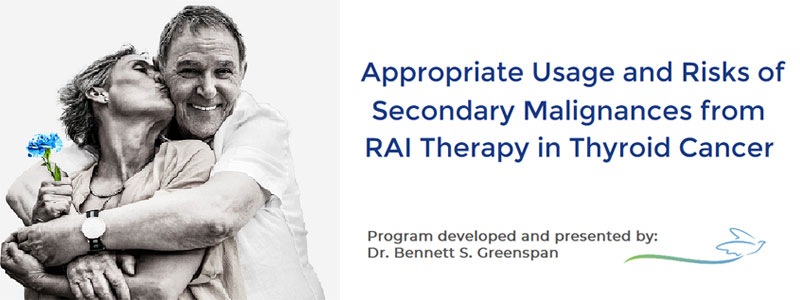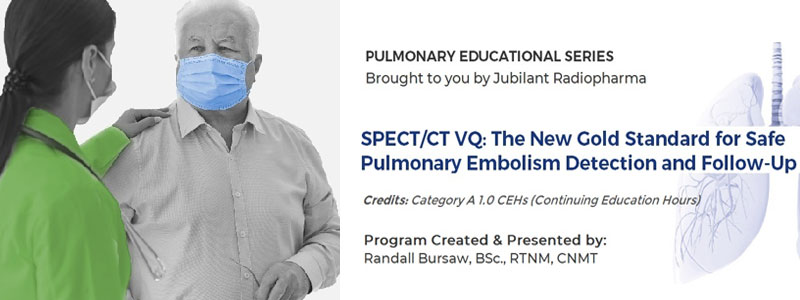Endocrinology Webinar Series

Title: Watchful Wait in Low Risk Thyroid Cancer? Why Wait?
Overview: In this course, attendees will review key concepts leading to the critical evaluation of literature on Thyroid cancer, particularly low risk. They will also learn about the impact of guidelines on clinical decision making and ways to address the challenges facing endocrinologists and surgeons when planning treatment of low risk Thyroid Cancer patients.
Special Guest Speaker: Douglas Van Nostrand, MD, FACP, FACNM
Click here to watch a recording of the session

Title: Thyroid Cancer, Iodine Physiology and Oncopathophysiology: A New Take on RAI Theranostics
Overview: Attendees will review key concepts in oncogenic mutations and molecular alterations, their impact on thyroid cancer and “desensitization” towards iodine leading to a lack of response to radioiodine (RAI). Attendees will also learn about the latest advances in pathway inhibitors which appear to enable “re-differentiation” which in turn may lead to a more personal/precise patient treatment along the Thyroid Cancer continuum.
Special Guest Speaker: Seza A. Gulec, MD, FACS, FACNM
Check back soon for new dates!

Title: SNMMI AUCs for Diagnosis and Treatment of Thyroid Cancer & ATA Guidelines: Not Mutually Exclusive
Overview: This session will review the SNMMI AUCS as well as the 2015 ATA guidelines for the diagnosis and treatment of Thyroid Cancer. It will discuss their distinct value, complementary nature and, using clinical cases, how to implement them.
Special Guest Speaker: Douglas Van Nostrand, MD, FACP, FACNM
Click here to watch a recording of the session

Title: Appropriate Usage and Risks of Secondary Malignancies from RAI Therapy in Thyroid Cancer
Overview: This course will review the recently published Appropriate Usage Criteria for RAI in DTC patients in line with CMS mandate, as well as acute and long-term side-effects associated with RAI.
Course Objectives:
1. Described the value and significance of AUCs document published by SNMMI on imaging and management of differentiated thyroid cancer
2. Explain the complementary nature of the AUCs and the 2015 ATA guidelines on thyroid cancer therapy
3. Explain the clinical equipoise of managing patients based on their risk of thyroid cancer recurrence
4. List the most common clinical applications of 131I therapy
5. Discuss practical application of AUCs and treatment guidelines in three clinical cases
Special Guest Speaker: This course features Bennett S. Greenspan, MD, MS, FACNM, FACR, FSNMMI, FAAPM.
Check back soon for new dates!
Cardiac Webinar Series

Title: Navigating Reimbursement for Cardiac PET
Overview: This course will focus on key reimbursement information and market trends pertaining to initiating or managing a cardiac PET program. Highlighted topics during the presentation will cover core reimbursement principles, 2022 Medicare updates for cardiac PET, and reimbursement and financial considerations when starting a program.
Course Objectives:
1. Identify key reimbursement elements for cardiac PET procedures
2. Understand Medicare coding and payment changes for 2022
3. Explore why reimbursement and financial modeling is integral to successfully starting a cardiac PET program
4. Identify reimbursement resources and contacts to help start a new cardiac PET program
Credits: Category A 1.0 CEHs (Continuing Education Hours)
Special Guest Speakers: Kathy Francisco, MBA, CPC and Amy Goldberg, RPh
Tuesday, March 1 | 4:00pm - 5:00pm
Thursday, March 3 | 12:00pm - 1:00pm
Wednesday, March 9 | 2:00pm - 3:00pm
Title: Quantification of Myocardial Blood Flow with Cardiac PET Imaging
Overview: The course will focus on myocardial blood flow (MBF) and flow reserve (MFR) quantification with Rb82 PET; including its clinical value, measurement techniques, key technical requisites and quality control steps to ensure accurate quantification.
Course Objectives:
1. Identify the difference between MBF & MFR
2. Explore how MBF and MFR are measured
3. Explore the different technical considerations for accurate quantification
4. Review the steps involved in quality control
Credits: Category A 1.0 CEHs (Continuing Education Hours)
Check back soon for new dates!
Special Guest Speaker: Jennifer Renaud, M.Sc., B.Eng
Title: The Value of Cardiac PET with Rubidium 82
Overview: The course will focus on the advantages of cardiac PET with Rb82 and the principal properties of cardiac PET including: high diagnostic accuracy, consistent high quality images, infusion techniques, myocardial blood flow and strong prognostic power.
Course Objectives:
1. Gain a basic understanding of Positron Emission Tomography (PET) and Myocardial Perfusion Imaging (MPI)
2. Discuss SPECT MPI vs PET MPI
3. Summarize advantages of cardiac PET
4. Expand knowledge of Rubidium 82 (Rb 82) PET MPI
Credits: Category A 1.0 CEHs (Continuing Education Hours)
Check back soon for new dates!


Title: SPECT/CT VQ: The New Gold Standard for Safe Pulmonary Embolism Detection and Follow-Up
Overview: This course will review how COVID has presented the Nuclear Medicine VQ with many safety and quality obstacles and demonstrate, using clinical cases and recently published data, that the SPECT/CT VQ is the ideal imaging tool for the most accurate post thrombotic lung function deficit assessment for optimal chronic follow-up patient care.
Speaker: Randall Bursaw, BSc., RTNM, CNMT
Course Objectives:
1. Participants will learn how to develop department protocols using published imaging data and VQ best practices.
2. Participants will learn how to safely balance Exam Quality with Patient and Staff Safety.
3. Participants will understand how the superior Sensitivity and Specificity of SPECT/CT VQ provides optimal patient outcomes and why it is the Gold Standard for post COVID imaging follow-up evaluation.
4. Participants will learn how quantification and segmental tools can assist in the faster, more accurate and reproducible interpretation of complex functional images.
Credits: Category A 1.0 CEHs (Continuing Education Hours)
Check back soon for new dates!
This session demonstrates how shifting from planar to SPECT and SPECT/CT lung imaging can improve diagnostic accuracy. A known advantage of SPECT/CT is that these functional images are significantly better than CT pulmonary angiogram (CTPA) alone, when imaging agents are delivered correctly. It provides multiple fused projections, which improves diagnostic accuracy and has been proven clinically safe for nearly 50 years: as it delivers a lower breast radiation dose than CTPA, with no renal toxicity or allergic contraindication for pulmonary embolism (PE) evaluation.
Check back soon for new dates!
Jubilant Radiopharma Resources
For an overview of our Reimbursement Services click here
For educational resources from our Radiopharmaceuticals Division, click here.
For educational resources from our Radiopharmacies Division, click here.
Online Continuing Education
In support of our mission of Improving Lives Through Nuclear Medicine, Jubilant Radiopharma proudly sponsors The Society of Nuclear Medicine and Molecular Imaging’s Value Initiative.
As contributing members of the Value Initiative’s Leadership Circle, we promote a wide-range of educational opportunities that help nuclear medicine physicians and technologists develop practice competency and expertise in state-of-the-art nuclear medicine, molecular imaging and radionuclide therapy, so they can achieve the high-quality desired health outcomes nuclear medicine can provide.
To start earning your credits today, please click on one of the courses below or click here to view the full catalog of live and on demand courses.